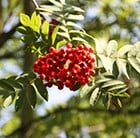Planting a tree

The secret to success when planting a tree is to make sure that it is well anchored; with shorter trees careful firming may be sufficient, but for trees over 1.5m a short stake and tree tie will help to keep the root ball in place. After planting, it's also worth covering the surface of the soil (avoiding the main stem) with a mulch to prevent competition from weeds and help retain moisture around the roots of the tree.
When should I plant?
Container-grown trees can be planted at any time of the year, except when the soil is frozen or waterlogged, but autumn is the ideal time for deciduous trees because the soil is still warm enough to encourage some root growth before the onset of winter. This helps the tree establish quickly so it is more able to withstand any hot, dry spells the following summer.
Container-grown conifers and other evergreens can also be planted in early autumn but in exposed gardens they are best planted in April (May in colder areas) so they can become established before the weather turns really cold. In these areas it's also worth putting up a protective barrier of windbreak netting after planting until the evergreens are established. Trees sold without any soil on their roots, known as bare-rooted or bare-root, should be planted during the dormant season only (November to March).
Six steps to success
- Dig a hole at least three times as wide and twice as deep at the tree's container. Mix the soil you've removed with well-rotted organic matter and leave to one side. If your soil is heavy, break up the sides and bottom of the hole by gently pricking the smeared surfaces with a fork - this will allow the roots to grow into the surrounding soil.
- Trees over 1.5m tall at planting time will establish more quickly if their roots are held firm. The best way to ensure this is to hammer in a 1.2m stake at an angle of 45 degrees after digging the planting hole. The stake should be positioned on the leeward side of the tree (i.e. downwind) so that it points to windward (i.e. upwind) - usually the south west.
- The tree needs to be planted at the same depth as it was in the pot. Check the hole is the right depth by laying a cane or piece of straight timber across the hole. If the tree is standing too high or too low you'll need to remove or add some of the soil in the bottom of the hole.
- I like to give a new tree a thorough soaking by standing it in a bucket of water for a couple of hours before it's planted. The easiest way to get a tree out of its pot is to gently lay it on its side, tap the rim of the container and then slide it out. Carefully tease out any roots that were circling around the bottom or sides of the pot so they grow away from the root ball and into the surrounding soil. Position the tree in the centre of the hole next to the stake (if used).
- Start to fill in the sides of the hole with the soil mixture, gently firming it down with your heel. Shake the trunk of bare-rooted trees before firming the first layer to make sure soil trickles down in between the roots. Regularly check the tree is upright. Once the hole has been filled, water really well once again. Then cover the surface of the soil with a generous layer of mulch, such as chipped bark or manure, to help prevent weeds and reduce the amount of water loss from the soil.
- After planting, attach the top of the stake nearest the trunk to the tree using a special adjustable tree tie with a protective spacer. This will hold the tree securely while preventing it from rubbing against the stake in windy weather.








